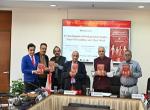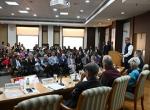The Vivekananda International Foundation held a Vimarsh on Raja and Praja in the Mahabharata on 5th October 2020. The speaker was Dr Bibek Debroy, Chairman, Prime Minister's Economic Advisory Council.
The event was initiated by Dr Arvind Gupta, Director VIF who gave the opening remarks, which was followed by an explanation of the concepts of raja and praja by Dr Bibek Debroy. According to him, during the ancient times, raja referred to a king who was able to delight his subjects and praja referred to the subjects. In modern day, one might say that the government plays the role of the raja and the citizens play the role of praja. The first raja mentioned in our texts was Prithu who was the son of an ordinary king known for being disrespectful towards the subjects, unjust and wicked. Due to his evil nature the brahmanas, who held a lot of influence during those days got together and killed the king. The death of the king, however, led to a major problem as the kingdom would no longer be stable without a king. So, the brahmanas got together and started kneading the dead king’s arm as a result of which a son was born who was named Prithu which means large. King Prithu was the first raja, he established agriculture, built cities, established rules for prevention of excessive exploitation of the earth and its resources. Hence the earth became his daughter symbolically and was therefore named Prithvi (earth).
Dr. Debroy explained that as citizens we want the government to do a limitless number of things in ways that we believe are required due to the inherent value judgements involved in the process of ranking and measuring without recognising that all governments have limited fiscal and administrative capacity. For example, one measure of development is the provision of piped drinking water. We, in reality, want clean drinking water. So why is drinking water from wells or streams not as good as piped drinking water? There may be therefore a requirement for prioritisation on the part of the government due to its limited capacity. How this prioritisation occurs, can be understood by taking in cognizance that in our history, throughout various time periods, the key responsibilities of government have been limited to the rule of law, dispute resolution, protecting the virtuous, punishing the wicked, protecting property rights, internal security, external security and defence. In our ancient scripture like the Puranas, the role of the raja was therefore much less as compared to the current role of the government. The raja was only expected to uphold and protect the core elements of governance that have been mentioned. The aim was to maintain peace and stability in the rajya. One-sixth of the earnings of each citizen of the praja went to the king as revenue. This mounts to almost 16% tax on the income. Today we expect the government to do much more with less revenues.

Some questions then arise as a result of the above: What is governance? How were the resources prioritised and stability maintained? To explore the difference between the word ‘governance’ and the word ‘government’, we ultimately have to look at the role of the citizens. The role of the government is to govern but the word ‘governance’ specifically refers to the relationship between the citizens and the government. A good way of understanding governance could be to quantify it. The World Bank regularly attempts to quantify this very concept. For this it has six different indicators using which it not only attempts to quantify governance but also compare the level of governance of different countries. In this aspect we must again recognise that, whenever we try to rank or measure something there comes in an inherent value judgement. So, if not quantification of governance, then a parametric outcome assessment could work. In the UNDP they make a human development report for development and deprivation. In the Mahabharata, after the rajsuya yajna the Rishi Narad went to king Yudhishtira and asked some questions, how is the kingdom doing? How are the citizens doing? Is taxation too heavy? How is the infrastructure performing? How is agriculture performing and many more such questions. Those questions if looked at carefully are not very different from the questions that any citizen today would ask the government and the ones used in the UNDP report. Similar questions for measuring the state of governance were also asked in the Valmiki Ramayana.
Once the concepts of the raja, praja and governance were explained, the speaker shifted focus to the concept of itihasa. Itihasa means history, it includes the Puranas, Ramayana and the Mahabharata. Here the speaker attempted to explain the large expanse of our scriptures and their coverage of various aspects and ways of life. For instance, the Ramayana itself has different versions in Sanskrit scripts. Similarly, we all go through sanskaras (16 in general) throughout our lives which are described in the Puranas. He gave the example that even the construction of temples is described in detail in the Matsya Purana. The description of how the image of gods and goddesses are to be moulded is in the Agni Purana.
Among the texts that were first translated into English were the Upanishads, Rigveda, Bhagavad Gita. Today what we know of the Dharma Shastras is largely thanks to the work of P.V. Kane. The speaker used this point to elaborate on the need of a P.V. Kane for Arthashastra (the ones other than the one produced by Kautilya). There are around 12 other Arthashastra texts which highlight the larger dharma of the king, political economics etc. One of the Parvas is the Raja Dharma Parva of Shanti Parva. There are 60 different Gitas out of which almost 20 are from Mahabharata and there are also some stand-alone Gitas, Gitas from the Puranas, Gitas from the Ramayana etc. Many of these Gitasalso explain the role of the king. There are many bits of wisdom spread across these texts. For instance, the concept that land disputes must be settled in the month of jaishtha (mid May-mid June) because there are no crops during that month, the air is clearer so it is easier to identify land borders.
Hinduism at its core is about obtaining the four purusharthas, namely, dharma, artha, kama and moksha. This is something Westerners overlook so we cannot leave it to the Westerners to analyse our texts. We must therefore understand our culture ourselves. The underlying concept in all of our texts is the balance between dharma, artha, kama and moksha. The speaker concluded by highlighting that ideal society does not exist anywhere but the concept holds importance as a symbol of the goal we have to work towards.
The webinar ended with an extensive discussion on techniques including AI (artificial intelligence) that can be used to translate more of our scriptures. Quite a few new ideas came up to facilitate our understanding of the ways our ancient civilisations functioned for ensuring effective communication between the raja and praja. In the end the speaker made an appeal to all scholars to act as foot soldiers of the forces of research into the annals of our glorious civilisational past.

_1.jpg)





Post new comment